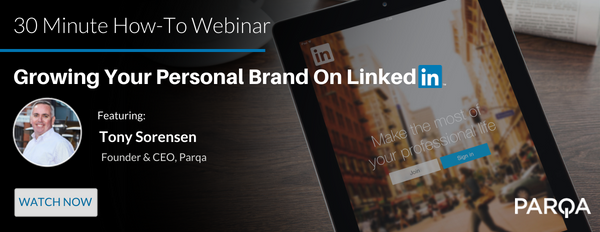As a digital marketer, 99% of my thoughts and recommendations usually focus on digital platforms. That said, it is essential to think through who your audience is and how they prefer receiving communication.
As recruiters, you’re an expert on outbound sales communication. What can you do to get in front of HR professionals that now spend 80% of their day online or your C-Suite network that spends 70% of their day away from their desk in meetings?
A while back, Parqa sponsored two different conferences. I went through this exercise first hand and wanted to share with you the importance of putting together an overall sales and marketing plan that encompasses both online and offline initiatives.
Let’s take a moment to set the stage before a typical conference or trade show. Many times, as a sponsor at an industry-related show, you can get the attendee list in advance. Along with this, you usually receive a post-show list of attendees. These lists are the key to preparing a successful communication plan.
Related Post: Why Recruiting Firms Should Hire a Digital Marketing Agency that Specializes in the Recruiting Industry ➢
Traditional, Offline, Sales
The offline sales process looks like this: Use the attendee list to determine if there’s anyone that you know attending. From there, you can look at the companies to see if you recognize any of them. Lastly, take a mental note of the companies that you need to get in front of. These companies may have been on your Tier 1 list to get into for years.
Once you have your mental lists and plan of attack, it’s show time! While at the show, have as many meaningful conversations as possible and determine the handful of conversations that are hot leads.
Post-show, back at your office, look at your stack of business cards one by one, adding everyone into your ATS/CRM, connect with everyone on LinkedIn, and start calling people to schedule consultations.
Digital, Online, Marketing
The digital marketing method is slightly different. After removing any competitors from the pre-show attendee list, use that list to create a beautifully designed email template.
Send the message to the entire conference list that you will be there and that they should come and see you at your booth. From there, develop a sequence of emails to send one week prior, the day before, and the day of the conference to ensure you are staying top of mind.
The show floor is the same as before, except this time, focus on sending emails to new contacts within 24 hours of meeting them.
Post–show there is a slight change. This time, using your business cards, put those people into specific email nurturing campaigns to continue working through the marketing funnel, as they have yet to “opt into” the sales funnel. From there, you connect with everyone on LinkedIn, and you continue to wait until someone fills out the form on your site asking for a free consultation.
Related Post: 3 Ways to Succeed with Candidate-Focused Marketing ➢
Bringing Offline and Online Together with Sales and Marketing
Now it’s time to combine the two. As a marketer, it was difficult for me to get into the sales mindset at first, so I can understand the challenge as a recruiter to adopt a marketing mindset.
Before the show, think back to your exact buyer. Start going through the attendee list and pull out all the attendees that you believe would be your ideal client. These people should get all your upfront marketing efforts.
Think about what will help break through the noise in their typical day. Send them a product or a postcard in the mail two weeks before the show – I assure you, snail mail is not dead! From there, pick up the phone and give them a call to personally invite them to the show.
Finally, make sure to send out an email to let them know, in writing, where you will be and when. Can they set up a time with you to meet at the booth? Are you going to be running a contest or special promotion while at the show? Share this information in that email to allow them to engage before the show.
While at the show, set up a page that allows people to give you their information digitally. Automate the step of inputting them into your ATS/CRM when you get back into the office and automatically opts them into getting future marketing communication from you.
Are you hosting a roundtable or speaking at a session? Have an email go out to your targeted list a couple of hours before your session. Remind them while they are making their session decisions to add you to the mix. From a sales perspective, don’t forget to take notes. Whether on their card or in a notebook after each conversation. You’ll want to personalize your post-show approach as much as possible.
Once you get back from the show, categorize your conversations by action item. Send more information, ask if they are ready for a discussion, or reach out and set up a meeting ASAP. Create a communication plan that allows these people to see your name a minimum of seven additional times over the coming months.
Use a mix of calls, LinkedIn, email, and snail mail. Send them blogs you’ve written via LinkedIn Messenger, send them an email with a link to a case study of a recent search you completed, send them one of your promotional products for their desk.
Your leads need to see your brand 10-14 times for them to act. The important part is to bust through the noise to get to them. Remember, you weren’t the only sponsor/speaker/vendor at the conference. It is essential to come up with ways to hit those touchpoints but in the most meaningful way possible.
At Parqa, we are currently in the middle of our post-show communication plan from our latest two conferences, and we can already tell that the upfront effort in mixing our online, offline, sales and marketing initiatives are paying off. We’d love to help you do the same!














